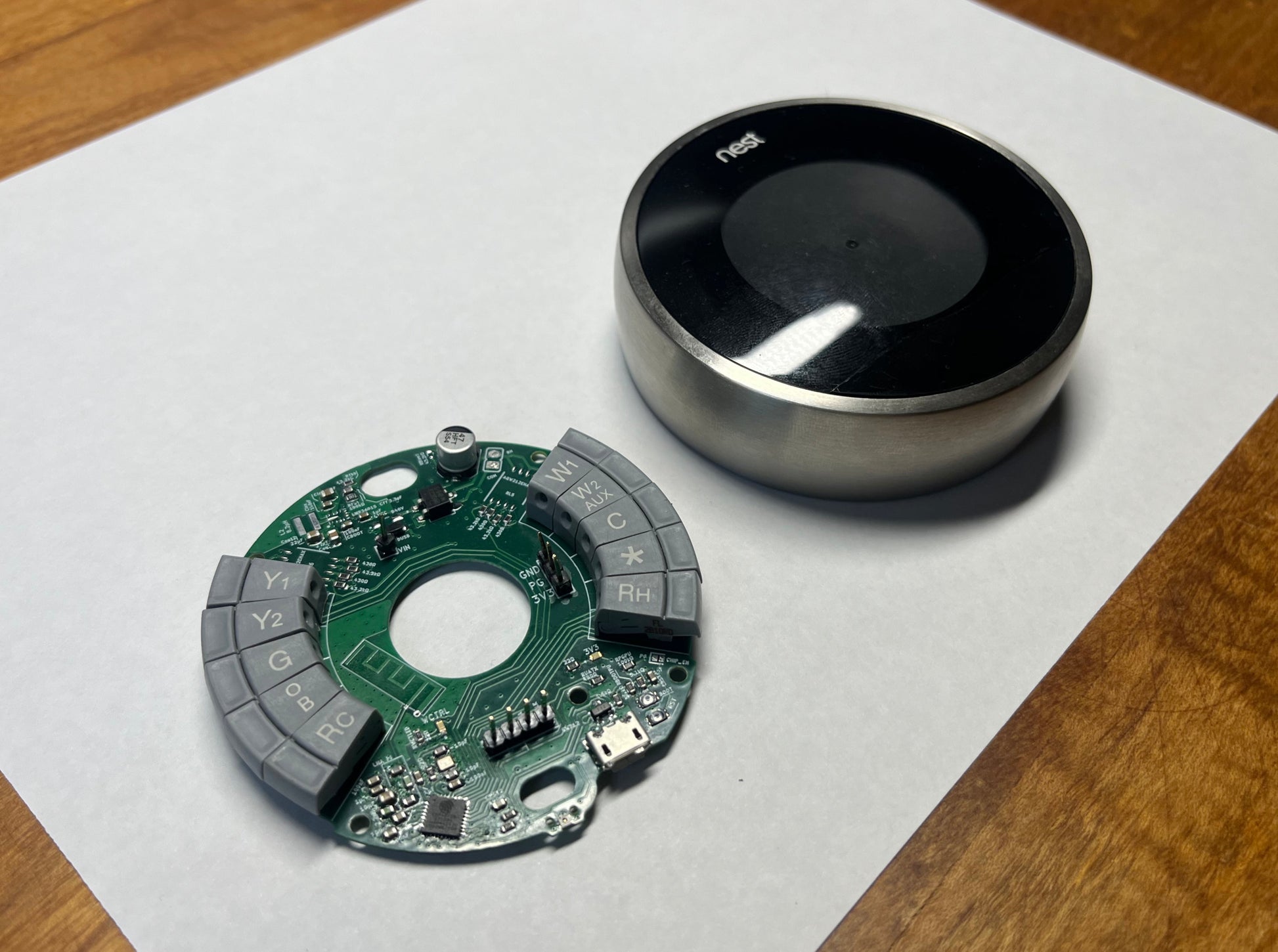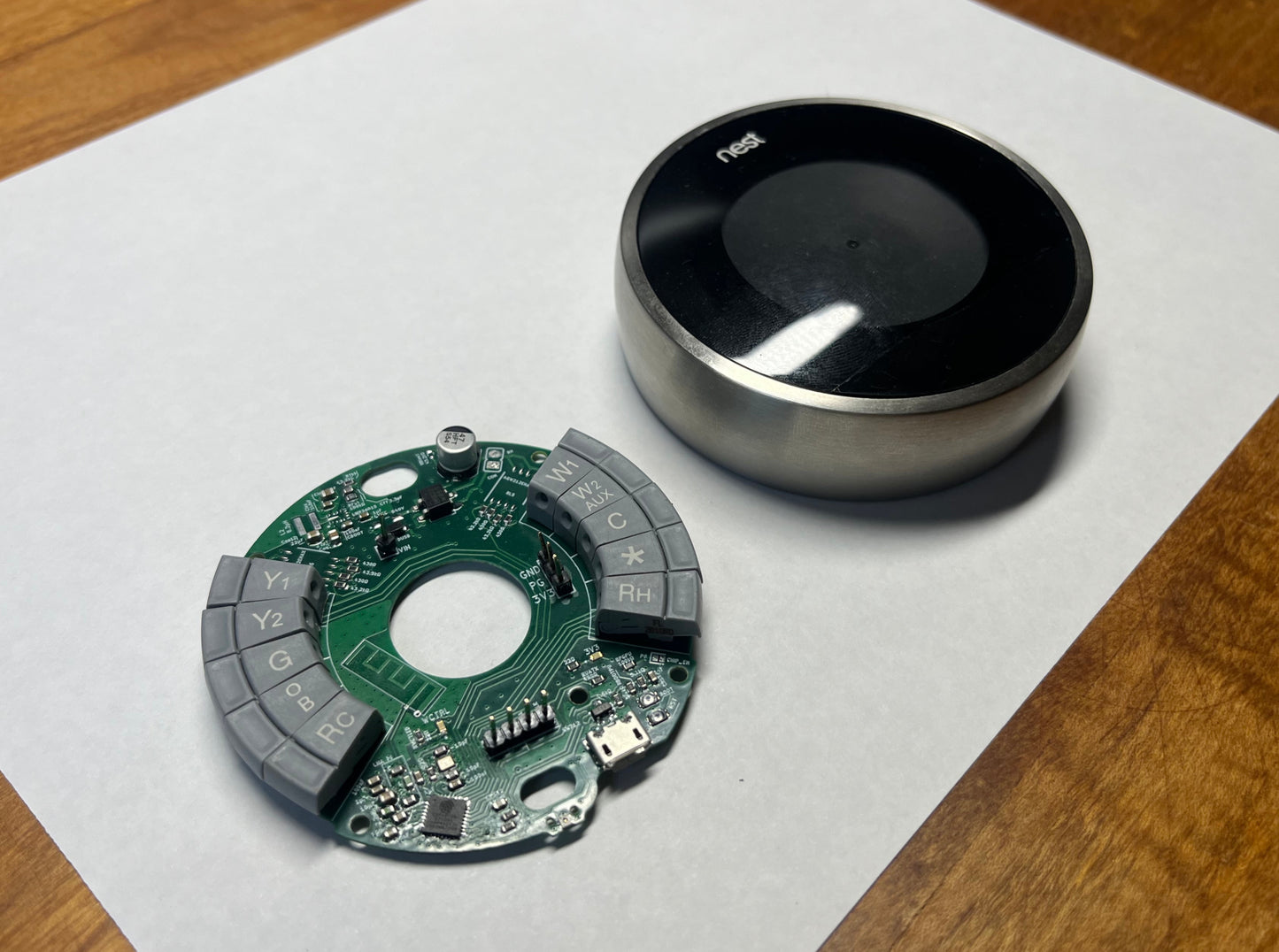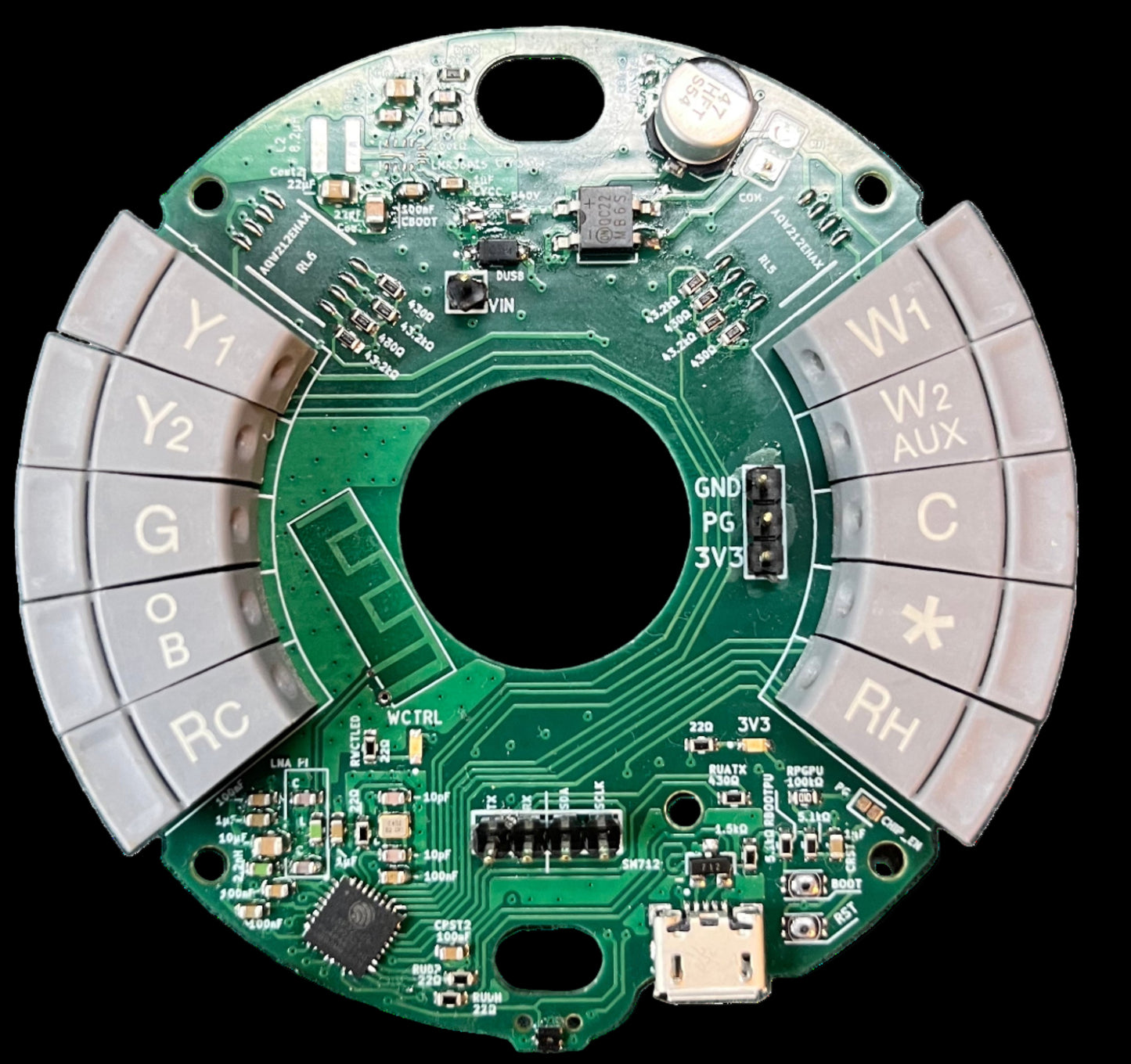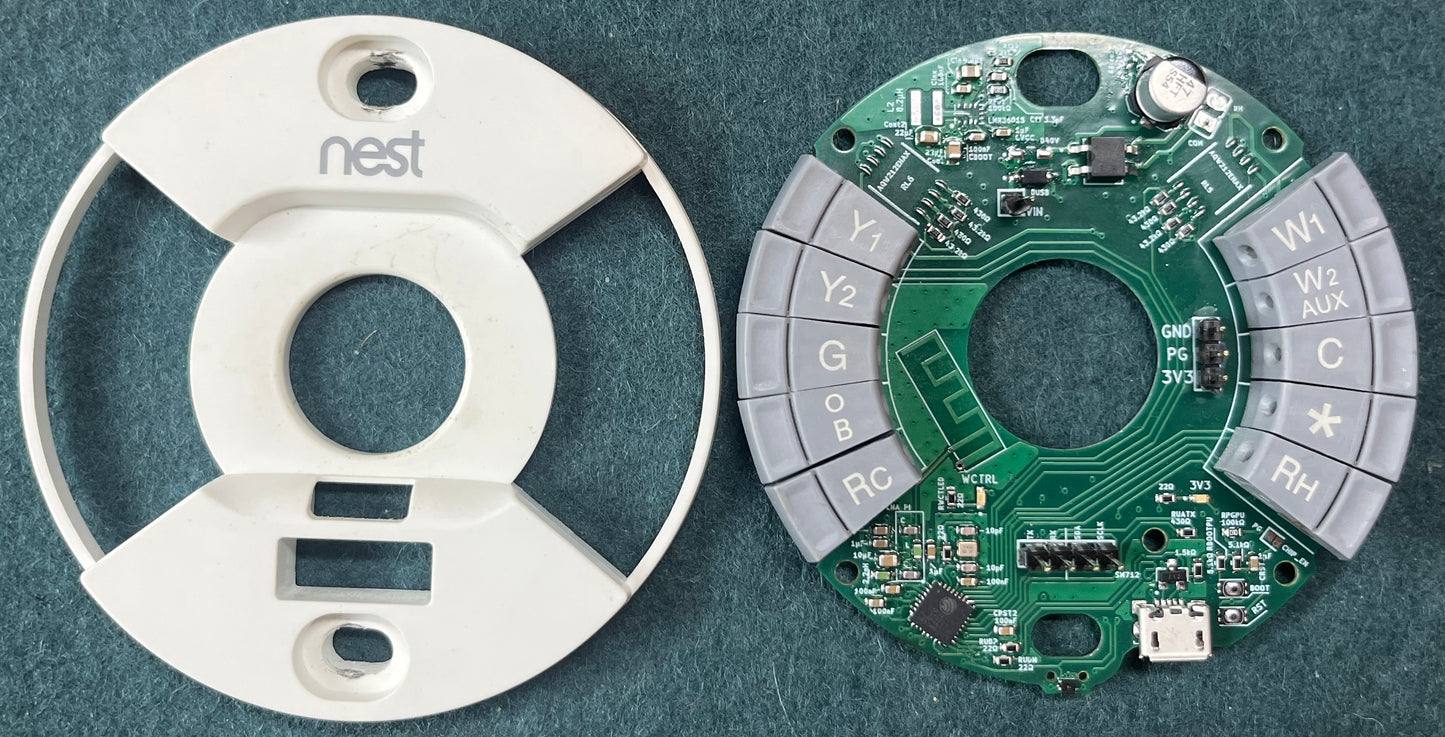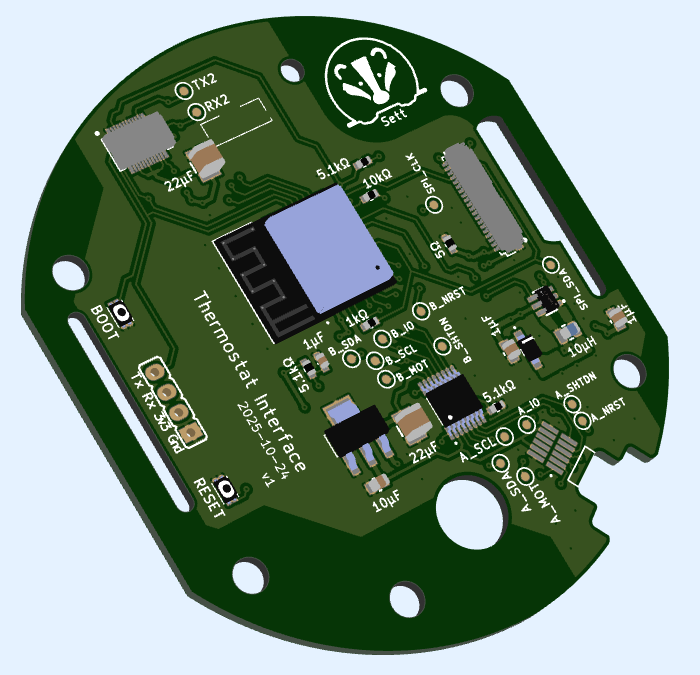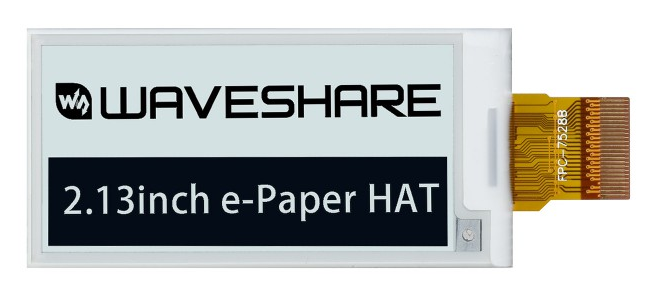
Should the Sett Thermostat switch to an e-ink screen?
A reader asked whether the Sett thermostat could switch to an e‑ink display. This post collects the display options and considers how e-ink compares to the existing color TFT LCD.
We'll look at the e-ink modules I evaluated, including considerations of e‑ink modules that could physically fit the enclosure, and how the size and visibility of an e‑ink option would compare.
A thermostat is the kind of control you glance at while walking by. Similar to a clock, it is generally not an actively-consumed interface. We don't expect people to interrupt their movement to stop and interact with a thermostat the way we might expect say a game console or a laptop. Because of this, a display that is easy to glance at is one of the most important factors for a thermostat - it's being interacted with passively almost all the time that it's on. Rarely, someone will come interact with it to adjust the temperature or mode. During these interactions, the user wants a responsive display that they don't need to spend a lot of time interacting with. So, we optimize for "glanceability" and a quick refresh rate. And, since the UI will feature large, simple shapes no matter which screen, the most important factors for "glanceability" are physical size and how a display presents light.
Why consider e‑ink in the first place?
E‑ink’s strengths match a thermostat’s role. It is reflective rather than emissive, so it doesn’t glow or cast light in a dark room and is less likely to be distracting at night when you walk past it. Contrast and tone remain stable across wide viewing angles, which helps when you glance at the device from down a hallway at a narrow angle. The paper-like finish provides a gentle reading experience that is well-suited for information that should be available at a glance but not demanding of your attention. Those properties suit a glanceable interface that favors clear typography over motion and gradients. The trade‑offs of the display technology alone are that updates are slower and partial refresh can ghost, but for a wall‑mounted interface that changes infrequently, those limitations are manageable.
The mechanical constraint: a 75 mm “lens” volume
The Nest 2nd gen thermostat's mounts and touch ring enclose a circle of 75mm in diameter. Anything we drop into that space must fit inside a 75 mm circle, and the original display comes with a molded plastic LCD holder which is 5mm at its edge and "crowns" to a thicker center, creating a lens‑shaped cavity:

For any rectangle to fit in a circle, its diagonal must be less than or equal to the circle’s diameter; a useful corollary is that rotating a rectangle doesn’t change this - the minimum containing circle depends only on the diagonal, not orientation.
Now, the original LCD is a square of 320x320px (constrained to a circle). Since it's a square, the side lengths be equal, so a square inscribed in a 75 mm circle must be at most 53.03 mm per side.
That matters because it tells us there is no way to use a square display module larger than 53 mm on a side. When looking at square e-ink panels available off-the-shelf, the largest size that fits within 53mm is only ~39mm (1.54 inch). The practical path for an e-ink display with a larger screen is thus a rectangular module.
What rectangles fit?
On AliExpress, eBay, and display manufacturer sites like Waveshare, there are standard sizes of e-ink display modules.
The 2.13″ class of rectangular e‑ink modules has outline dimensions of 59.20 × 29.20 mm. That gives a diagonal of 66 mm, which is safely within a 75 mm circle. Variants at 2.15″ with a 60.8 × 31.8 mm outline also pass, at roughly 68.6 mm diagonal.
Stepping up to the next common sizes does not. A 2.66″ module with dimensions around 71.82 × 36.30 mm has an ~80.5 mm diagonal and fails the 75 mm limit. A roughly square 72.5 × 69 mm 3.4″ module is also too large, at over 100 mm.
The best e-ink candidate
Among the 2.13″ modules, one common outline is 59.2 × 29.2 mm with an active area of 48.55 × 23.71 mm and 212 × 104 pixels. These modules have a full-screen refresh time on the order of a couple of seconds and support partial refresh. Mechanically it leaves about 4.5 mm of radial margin inside a 75 mm circle, enough for adhesive, tolerances, and a modest bezel. This module would be the best fit of the commonly available ones.

How it compares to the current round TFT
The project today uses a TM025ZDZ01‑class 2.48″ round TFT at 320px × 320px. Let's compare the "glanceability" of the existing screen with this best e-ink option.
Compare the apparent size and viewing experience between a 2.48″ diameter circular display versus a 2.13″ diagonal rectangular e‑ink display. Consider how a person standing in the room would perceive the size difference, the shape difference, and how the information density and readability would compare from typical viewing distances of 3‑10 feet.
Visual perception scales with area. The single biggest factor in glanceability is how much of your field of view the information can occupy.
The e‑ink active area is roughly 48.55 × 23.71 mm, or about 1,152 mm². The 2.48″ (63mm) circle has an area about 3,117 mm². The round TFT therefore presents about 2.7× the active area.
The TFT presents a canvas that is physically 2.7x larger. A larger object simply provides a bigger target for your visual system. At a typical viewing distance of 3–10 feet, the difference is stark, and the larger visual target means the thermostat is easier to look at while glancing from across the room.
As far as crispness and legibility, we can look at pixel count. The 2.13″ e‑ink panel has 212 × 104 = 22,048 addressable pixels. A round 320 × 320 display renders a circle inside that matrix; the usable pixels are about π/4 of the square, roughly 80,400. On raw pixel count, the TFT delivers about 3.6× more addressable pixels than the 2.13″ e‑ink.

The second key difference is how the displays create contrast. The TFT is an emissive display; it generates its own light. This allows it to create a high-contrast image that is dramatically brighter than its surroundings, especially in a dim room. In contrast, the e-ink screen is reflective. Like paper, it has no light of its own and depends entirely on ambient light.
Another important consideration is color, a useful tool for conveying information quickly and intuitively. For example, the background could be a soft orange when the system is heating, blue when cooling, and perhaps green when in an energy-saving "away" mode. This kind of color-coding reinforces the thermostat's current state and can be understood with a quick glance from across a room, without needing to read any text or icons. To design the same interface in monochrome you would use clear typography and icons, such as a flame for heating or a snowflake for cooling, but it might be harder to understand the state of the thermostat from only a quick glance rather than an inspection of the icons.
What I would build if I were to go e‑ink
I would design a bezel that puts the rectangle of glass of the waveshare 2.13" module at the center of a circle. The bezel would be a 75 mm‑diameter cylinder with a 3.5mm height, with pillars designed into it for mounting standoffs and holes for the FPC "tail" connector feeding from the display into the underside. Then, I'd cut a close-fitting cover of 1.5mm out of tough polished acrylic that can glue into place and have black paint applied to the back to hide the portions that need it. I would 3d-print the bezel in resin or Nylon and replace the existing bezel module with it.
Conclusion
The choice between e-ink and the existing round TFT comes down to a user experience decision: the TFT offers a larger and brighter canvas that actively presents information. The e-ink provides a calmer, more subtle display that is a wide‑angle, non‑distracting reading experience that suits a wall‑mounted device you glance at many times a day, but this display will be only half the visible area of the existing TFT.
For Sett, power draw, unit cost (these modules are about $4), and durability aren't the deciding factors, so the choice mainly comes down to ergonomics: physical size, how the display presents light, refresh behavior, and the UI patterns each technology supports. For Sett, the ease of manufacture (limited to existing parts/materials and only needing to fabricate PCBs) and a push for simplicity, combined with the larger information display, makes the existing TFT win out.
For the right DIYer who is talented with CAD and 3d printing, and prefers e-ink, such a variant is more than feasible using a 2.13-inch rectangular module and comes with the noted benefits of e-ink. Let me know if you decide to pursue this route!
